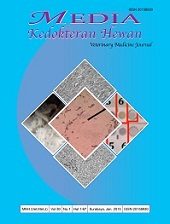Exploration of the Antibacterial Potential from Rice Eel Skin Mucus (Monopterus albus) Against Bacteria Aeromonas hydrophila, Escherichia coli, and Staphylococcus aureus
Downloads
The skin mucus of the rice eel (Monopterus albus) contains various antibacterial compounds and has the potential as a synthetic antibiotic. This research was conducted to explore the potential antibacterial power of the rice eel skin mucus against some pathogenic bacteria in freshwater fish. The bacteria were isolated from five samples of rice eel cultivation ponds belonging to Mr. Sabwan and then challenged with the mucus of the eel's skin through diffusion tests using paper discs. The rice eel skin mucus tested its antibacterial activity against three species of freshwater bacteria, Aeromonas hydrophila, Escherichia coli, and Staphylococcus aureus, by testing sensitivity and inhibitory zones. The inhibitory zones of each bacterium were measured using Vernier caliper which refers to the standardization of the inhibitory zone: < 4 mm no activity, 5-9 mm weak, 10- 14 mm medium, and > 15 mm strong. Test results showed that the eels' skin mucus could inhibit the growth of bacteria Aeromonas hydrophila, Escherichia coli, and Staphylococcus aureus.
Akmal, M., Rahimi, M. A., Hafeez, U. R. M., Hussain, A., & Choi, T. J. (2020). Isolation, Characterization, and Application of a Bacteriophage Infecting the Fish Pathogen Aeromonas hydrophila. Pathogens, 9(3):215.
Al Rosyad, F. A. (2012). Uji Aktivitas Antibakteri Ekstrak Etanol Pare (Momordica charantia L.) terhadap Pertumbuhan Escherichia coli secara in vitro. Skripsi. Universitas Jember.
Dinas Perikanan dan Pangan Kabupaten Banyuwangi. (2018). Profil Perikanan Budidaya Dinas Perikanan dan Pangan Kabupaten Banyuwangi. p. 16.
Direktorat Produksi dan Usaha Budidaya. (2017). Buku Panduan Pengelolaan Paket Bantuan Pemerintah. Budidaya Ikan Lele Sistem Bioflok. pp. 1-7.
Hammad, A. M., Watanabe, W., Fujii, T., & Shimamoto, T. (2012). Occurrence and Characteristics of Methicillin Resistant and Susceptible Staphylococcus aureus and Methicillin Resistant Coagulase-negative Staphylococci from Japanese Retail Ready to Eat Raw Fish. International Journal of Food Microbiology, 156: 286-89.
Hanson, L. A., Liles, M. R., Hossain, M. J., Griffin, M. J., & Hemstreet, W. G. (2012). Motile Aeromonas Septicemia. FHS, 129: 1-11.
Hilles, A. R., Mahmood, S., Kaderi, M. A., & Hashim, R. (2019). Evaluation of The Antimicrobial Properties of Eel skin mucus from Monopterus albus Against Selected Oral Pathogens and Identification of the Anti-Oral Bioactive Compounds Using Lc Qtof Ms. Journal of Microbiology, Biotechnology and Food Sciences, 9(1): 140.
Himedia. (2018). Technical Data: Mueller Hinton Agar. Himedia Laboratories. Mumbai, India.
Kurniawan, N. S. (2017). Pengaruh Pemberian Edukasi Door to Door Penggunaan Antibiotik pada Infeksi Saluran Pernapasan Akut terhadap Pengetahuan Ibu-Ibu di Desa Wanogara Kulon Kecamatan Rembang Kabupaten Purbalingga. [Doctoral Dissertation]. Universitas Muhammadiyah Purwokerto. Kusriningrum, R. S. 2011. Perancangan Percobaan. Surabaya. Penerbit Dani Abadi, pp. 31 – 39.
Li, Y. J., &Hu, B. (2012). Establishment of Multi Site Infection Model in Zebrafish Larvae for Studying Staphylococcus aureus Infectious Disease. JGG, 39: 521-34.
Maryland Hedmon, O. (2018). Fish Mucus: A Neglected Reservoir for Antimicrobial Peptides. AJPRD, 6(4): 6-11.
Nonutu, S. E., Pangemanan, D. H., & Mintjelungan, C. N. (2021). Uji Daya Hambat Ekstrak Ikan Nike (Awous melanocephalus) terhadap Pertumbuhan Bakteri Fusobacterium nucleatum. eGiGi. 9(2): 238-242.
Patil, R. N., Kadam, J. S., Ingole, J. R., Sathe, T. V., &. Jadhav, A. D. (2015). Antibacterial Activity of Fish Mucus from Clarias batrachus (Linn.) Against Selected Microbes. Biolife, 3(4): 788-91.
Praja, R. N., Yudhana, A., Haditanojo, W., & Oktaviana, V. (2021). Short Communication: Antimicrobial properties in cloacal fluid of olive Ridley sea turtle (Lepidochelys olivacea). Biodiversitas, 22(9): 3671-76.
Razak, L. A. A., Musa, N., Jabar, A., & Musa, N. (2019). Therapeutic Potentials of Excoecaria Agallocha Against Gram Positive and Gram-Negative Fish Bacterial Pathogens. JIDHealth, 2 (2): 87-94.
Saputra, I., & Indaryanto, F. R. (2018). Identifikasi Bakteri Aeromonas hydrophila pada Komoditas Ikan yang di Lalulintaskan menuju Pulau Sumatera melalui Pelabuhan Penyeberangan Merak. Jurnal Perikanan dan Kelautan, 2089:3469.
Tamala, A. R., Ramadhani, F. R., Hasanati, J. N., Ryandra, R., Annisa, R. T., Putri, I. R., & Fifendy, M. (2021). Persepsi Peternak Ikan Air Tawar terhadap Parasit pada Budidaya Perikanan. Prosiding Seminar Nasional Biologi, 1(1): 510-25.
Van Duin D., & Paterson, D. L. (2016). Multidrug Resistant Bacteria in the Community: Trends and Lessons Learned. Infectious Disease Clinics, 30(2): 377-90.
Widyaningsih, W., Supriharyono, & Widyorini, N. (2016). Analisis Total Bakteri Coliform di Perairan Muara Kali Wiso Jepara. MAQUARES, 5(3):157-64.
Copyright (c) 2024 Ratih Novita Praja, Aditya Yudhana, Didik Handijatno, Wardatul Qoryah Al-Madinah, Jonathan Mark Hamonangan, Alivia Khairina Insani, Nindya Pradnya Prameswari, Dhenatra Rifqy Prasetyo, Shifa Salsabilla Praja

This work is licensed under a Creative Commons Attribution-ShareAlike 4.0 International License.

Veterinary Medicine Journal by Unair is licensed under a Creative Commons Attribution-ShareAlike 4.0 International License.
1. The Journal allows the author to hold the copyright of the article without restrictions.
2. The Journal allows the author(s) to retain publishing rights without restrictions
3. The legal formal aspect of journal publication accessibility refers to Creative Commons Attribution Share-Alike (CC BY-SA).





11.jpg)







11.png)













